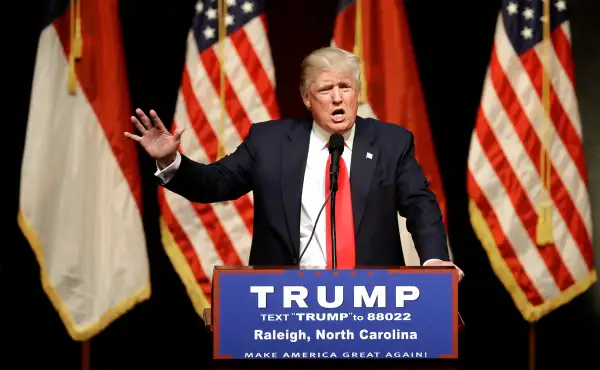So ... Where's That New Trump Tax Plan?
Money is not a client of any investment adviser featured on this page. The information provided on this page is for educational purposes only and is not intended as investment advice. Money does not offer advisory services.

Update, July 18: Last week, I reported on the coming Donald J. Trump tax plan. The new, long anticipated plan that was going to make Trump’s tax ideas practical, or close to it. Stephen Moore, Trump’s senior economic adviser, promised the new plan would cost two thirds less than Trump’s original, and would be out late in the week. Certainly before the convention.
Now the Republican convention is starting, and we’re still waiting. “Probably just broadbrush this week," Moore wrote in an email, saying that the details will probably be released next week, in a speech in Detroit. We’ll see. “Broadbrush” actually sums things up pretty nicely; that’s how the Trump campaign has operated all along. Every week, there’s noise from more traditional Republicans that Trump will come around on actual policy. There’s really no evidence of that.
If you are looking for policy specifics from Trump, they’re still hard to come by. But there’s one feature of the Trump style of which we can be pretty certain: He doesn’t have much patience for policy wonks, including those from his own party.
***
Yes, there really will be a new Trump tax plan. And yes, the tax cuts will still be huuuugggge. And no, there’s still no good way to pay for it.
Here’s some backstory: Two months ago, Donald Trump announced he was rejiggering his tax plan, with the help of luminaries of the conservative economics scene. There was celebration among the GOP establishment that they’d reign in the proposal—you might call it “cut-and-spend”—that cost more than any other candidate’s.
Then: crickets.
Stephen Moore, Trump’s senior economic advisor, promises that a new Trump plan really will be out soon. He said in an interview with Money on Friday that the plan is just waiting for the candidate’s approval, and should be out later this week. The re-write, Moore promises, will be “true to the principles of the original. We’ve just made some modifications to make sure the numbers add up.”
Moore says that overall he’s managed to cut the cost of Trump’s proposal by two-thirds. That probably means the cost of the plan might have come down from epic to merely enormous—still $200 billion a year or more.
Making the numbers “add up” is no small thing. Whatever tax bracket you fall into, Trump’s original tax plan was generous. It cut marginal tax rates at the top end to 25%, and those at the bottom to 0% for a couple’s first $50,000 of income. The non-partisan Tax Policy Center put the cost at about $9.5 trillion over ten years, roughly tripling the current $400+ billion federal deficit. The right-leaning Tax Foundation put the total price of Trump’s tax cuts even higher, at $12 trillion, or $10 trillion if you make some aggressive assumptions about how tax cuts spur economic growth.
When the presidential campaign was just starting hardly anyone took the plan, or Trump's chances, seriously. As the campaign has progressed,Trump's tax plan has looked less and less realistic; just this week Politico derided it as "making the deficit great." So there is pressure on Trump to come up with a plausible plan for governing.
What will the revised plan look like? Most likely it will a) not give anyone, rich or poor, the kind of tax breaks Trump originally envisioned; b) rely on some optimistic accounting; and c) still be expensive enough to raise the government deficits 50% or more.
Let's take those one by one:
• Fewer breaks: Moore says that the new Trump tax plan will be “80% similar” to the Congressional tax plan presented in late June by Paul Ryan. “It’s like when Reagan had his tax plan, and Jack Kemp had his,” says Moore (for those too young to remember the Great War, Jack Kemp was a football player beloved by fiscal conservatives).
Moore says that he’s fiddled with the rates, and “found ways to pay for” Trump’s plan by eliminating deductions. Cutting deductions is probably a big minus for those in high tax states, like New York and California (which, perhaps not coincidentally, vote Democratic). As for rates, Trump’s top tax rate was a sweet sounding 25%. Ryan’s is 33%. A couple earning $100,000 would be in Trump’s 10% tax bracket and in Ryan’s 25% bracket. It's not clear what Trump's final proposed number will look like, but it won’t be surprising if it’s closer to the Congressional plan.
• Hopeful accounting: “Dynamic scoring” is the preferred mechanism of Republican-leaning economists to reduce the apparent cost of tax cuts. That means taking into account the broader economic effects of tax cuts. For instance, if you cut taxes on capital investments, then companies will invest more money, the economy will grow, and the government will make back some of the tax cut. In principle, that’s unobjectionable. In practice, some of the claim made for economic growth are very optimistic.
Moore says that with dynamic scoring, he’s been able to get the cost of Trump’s tax cuts down to about $200 billion a year. Assuming the new Trump plan costs about a third of the original, than means Moore calculates the tax plan will spur enough economic growth to throw back an extra $100 billion to the U.S. Treasury. Those numbers are very squishy. On the state level, dynamic scoring has in many cases been a major bust. Kansas, for instance, thought its big tax cuts would create enough economic growth to largely pay for themselves. In actuality, none of that materialized.
• It's still a very expensive plan: No matter how hard you work to fit the Trump plan into a skinny suit, it still won’t look handsome to traditional fiscal hawks. If you accept Moore’s calculations of a $200 billion a year cost, it’s still the biggest tax cut in history. For comparison, the Congressional Budget Office, the gold standard in tax calculations, estimates the cost of the 2001 tax cuts at roughly $70 billion to $100 billion a year in George W. Bush’s first term, and $100 billion to $150 billion a year in his second.
The combination of years of tax cuts and the costs of paying for the 2008 economic meltdown blew a huge hole in the federal budget. Last year, the deficit was at about $435 billion, an improvement over previous years. Adding $200 billion is within the realm of plausibility—frankly, Trump's original plan wasn't—but it's still not what fellow Republicans are looking for.
The one thing that might make the numbers really work out is a similar cut in the cost of government. Certainly that is something Republicans are hoping for. To the suggestion that making $200 billion in tax cuts would mean some cuts in government, Moore said, "Yes, we're going to do that." That's a promise you've heard before. So far, it's never been fulfilled.
Correction: A previous version of this article incorrectly stated that the Tax Foundation anticipated that Donald Trump’s original tax plan would decrease federal revenue by $12 billion over ten years; the correct number is $12 trillion.
